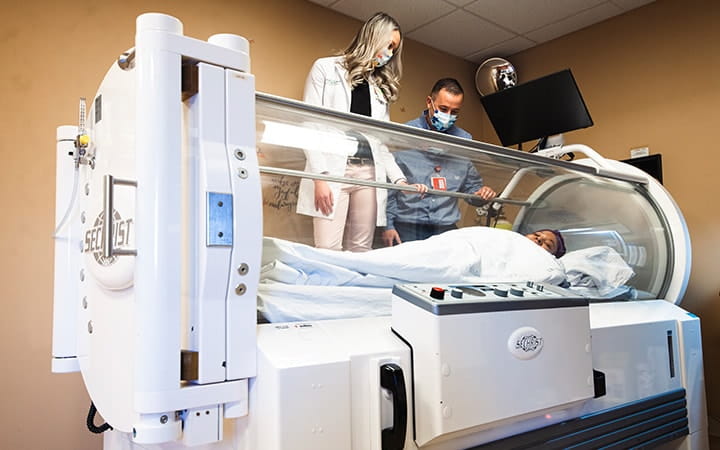The Healing Power of Hyperbaric Oxygen Therapy
September 21, 2022

Hyperbaric oxygen therapy (HBOT) is a noninvasive, painless treatment that supports the body’s natural healing capabilities. It does this by delivering high concentrations of oxygen to the bloodstream to help heal persistent wounds, injuries and infections.
The Benefits of HBOT
Under normal conditions, the air we breathe contains a mixture of gases, of which about 21 percent is oxygen. During HBOT, a patient breathes 100 percent pure, medical grade oxygen. They do this while relaxing in a specially designed, pressurized chamber.
High concentrations of oxygen can enhance your body’s healing power to repair itself, rehabilitate an injury or promote healing of a chronic wound. It can also help to rejuvenate cells and tissue that are at risk of dying due to diminished blood supply. HBOT promotes wound healing and other health benefits by:
- Increasing blood flow
- Decreasing inflammation and swelling
- Weakening infection-causing bacteria
- Increasing the body’s ability to fight free radicals (unstable molecules that can build up in cells and cause damage)
- Stimulating the growth of new blood vessels
“Hyperbaric oxygen therapy is a phenomenal adjunctive therapy for wound management. It is extremely helpful in the most complicated and severe cases and helps us to save legs and lives,” says Jacqueline Donovan, DPM.
How it Works
Normally, the oxygen we breathe is delivered to tissues and organs in the body by the red blood cells. During HBOT, the pressurized environment allows the oxygen to be dissolved directly into the blood plasma – a liquid component of blood that transports proteins, hormones and nutrients. Plasma accounts for more than half of the body’s total blood volume.
The plasma carries the pure oxygen deep into the body’s tissues, including the lymphatic system and the cerebrospinal fluid surrounding the brain and spinal cord. This results in a much higher concentration of oxygen within the body – up to 1,000 percent higher or more than is usual. In people with certain medical conditions, this delivery of highly concentrated oxygen via the plasma can be therapeutic and boost the body’s natural ability to heal.
Conditions Treated by HBOT
Hyperbaric oxygen therapy is approved by the FDA to treat a wide variety of illnesses and injuries, including hard-to-heal or chronic wounds. Some of the conditions that may be treated with HBOT include:
- Carbon monoxide poisoning
- Crush injuries
- Diabetic foot ulcers
- Failed skin grafts and flaps
- Gangrene
- Necrotizing soft tissue infections (occurs when most or all of the cells at a particular area of the body die due to disease, injury or diminished blood supply)
- Osteomyelitis (infection and/or inflammation occurring in the bones)
- Radiation-related tissue damage
- Severe burns
- Traumatic ischemia (a condition in which blood flow is restricted to a part of the body)
Hyperbaric oxygen therapy is very safe with few risks and side effects. In rare cases, patients may experience treatable side effects such a pressure injury to the ear or lungs, low blood sugar or temporary vision changes.
What Happens during an HBOT Treatment Session
Once your doctor has determined that HBOT is an appropriate option for you, he or she will develop a treatment plan based on your specific condition, the severity of symptoms and your health goals. This will help determine the number of treatment sessions and the level of pressure in the chamber. Many conditions will require 20-40 treatments over a four- to six-week period, with each session lasting between 90 minutes and two hours.
At the beginning of each session, a technician will check your vital signs and review a safety checklist, confirming you have removed all jewelry, watches and electronic devices, and have not applied any lotions or perfumes. You will be provided a 100 percent cotton gown to wear for both comfort and safety. Unlike synthetic fibers, cotton does not carry static, which can pose a safety risk during treatment.
You will also be given a water bottle. Sipping water can be helpful to clear your ears as the chamber pressurizes, similar to the ear-popping sensation experienced on airplanes.
From that point on, you simply relax in the specialized chamber and breathe normally. You can listen to music, watch TV or a movie or drift off to sleep. Your technician will maintain visual and voice contact with you throughout the treatment session to address any questions or concerns you might have. At the end of your session, the technician will check your vitals again and you will be free to resume your day. There is no recovery time needed.
Is HBOT Right for Me?
Hyperbaric oxygen therapy isn’t appropriate for everyone and requires a significant commitment from the patient to attend all prescribed sessions. If this therapy is recommended for you, we encourage you to have an in-depth conversation with your doctor to discuss the benefits and potential risks of this highly specialized treatment.
Related Links
Hyberbaric oxygen therapy is just one component of the comprehensive wound care services offered by University Hospitals at several convenient locations. Our multidisciplinary team of wound care experts, vascular surgeons, plastic surgeons and other specialists carefully evaluate every wound to develop a personalized treatment plan.


